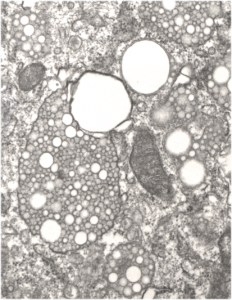There is an amazing thing that happens to fluorocarbons, in general, when they are taken in by phagocytic cells in the body. It was my observation in the mid 1970s and it remains today, but not well reported: that is — that many (depending upon what species of perfluorochemical it is) types of perfluorocarbon, whether breathed or injected as emulsions, tend to go through a phase of bubble coalescence and then re-emulsification – by the lysosomal enzymes) before they are finally “exhaled” through the cell membranes. I was pretty sure I could tell which perfluorocarbons would be removed in a timely manner from the body by how they behaved in the re-emulsification processes within lysosomes.
Here is an alveolar macrophage from the lung of a mouse which liquid-breathed E2 for three hours and was allowed to recover for 5 days before lung tissue was taken. See the two types of droplets of E2…. some tiny and some coalescing into bigger droplets. All the dense material around the droplets i believe to be lysosomal enzymes. This image below is a crop (unfortunately the original print i marked all over and couldn’t clean, so this is a rescan of the negative… i don’t have a wet darkroom any more) it could be printed again, and scanned, and pseudocolored (i might do it ?? to make a great poster in addition to being a useful image for studying. (unretouched except for contrast enhancement of the scanned negative – neg 1340 block 4835 swiss albino mouse 16.15g, 3 hrs liquid breathing five days recovery, right mid lobe tissue block, 1-30-1975, fixed in modified Karnovsky’s and osmium. There are literally hundreds and hundreds of little E2 droplets and a few big ones.
